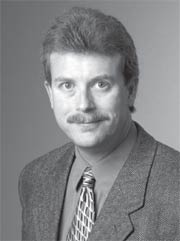Advocacy in action
 Have you considered committee
service?
Have you considered committee
service?
I would like to use this month’s column to encourage all of our membership, and particularly our younger members, to consider serving on an AASV committee. This is one of the best ways you can serve the association, gain additional knowledge about a specific part of our profession, and share your knowledge and experience with your colleagues. Serving on one of our issue-based committees is an excellent way to influence the future of the association and our profession as well as learn about how the association functions.
The AASV Board of Directors has established a number of committees, each responsible for providing the board with information about a specific issue and guidance to direct the formation of official positions. In addition, the committees are often called upon to provide educational materials for the membership or to review proposals from outside organizations and regulatory agencies.
Committee activities
The Foreign Animal Disease Committee recently reviewed a number of educational materials, including “Got Tonsil” and a classical swine fever (CSF) brochure that was part of a project to educate veterinarians and veterinary students about the CSF surveillance program. They are now considering the development of an emergency response plan for AASV.
The Communications Committee has begun updating the image library on the AASV website and has undertaken the challenges associated with recording presentations and speaker interviews at the annual meeting.
The Welfare Committee is initiating a review of the euthanasia guidelines in light of recent equipment changes and new scientific reviews of some methods discussed in the existing brochure.
The Pork Safety Committee is exploring issues associated with injection methodologies and pre-harvest issues impacting foodborne illnesses.
The PRRS Committee is preparing to survey producers and practitioners to determine what issues need to be addressed in order to promote the control and potential elimination of the PRRS virus from North American swine herds. They’re also attempting to standardize the terms we use to discuss this disease.
The North American PRRS Eradication Task Force is working to establish state-level groups of stakeholders including producers, veterinarians, researchers, and animal-health officials to promote discussion of PRRS control efforts at the local level.
The Membership Committee is working to identify additional value that the association can bring to its membership, as well as improving retention rates of existing members. Their activity is supported by that of the Student Recruitment Committee and the Collegiate Activities Committee which work to identify ways to interest veterinary students in becoming AASV members.
The Professional Development Committee is a relatively new committee charged with identifying ways to enhance our employment opportunities and to explore future roles for swine veterinarians.
The Wet Lab Committee just conducted the first-ever AASV summer conference for swine veterinarians at the Iowa StateUniversity College of Veterinary Medicine. The wet lab format was a great success, and the committee has been asked to begin planning for next year’s event.
The Pharmaceutical Issues Committee recently tackled the difficult task of clarifying the Japanese maximum residue limits (MRLs) imposed on domestic and imported agricultural food products. The committee developed a position statement for AASV and worked with the National Pork Board to provide a database containing updated MRLs for most antimicrobial products used in swine medicine.
The PCVAD Committee’s mission is to develop a plan of action to address the issues associated with disease and production challenges associated with exposure to porcine circovirus type 2. The committee proposed a name change (porcine circovirus associated disease; PCVAD) to better describe the myriad of disease syndromes associated with PCV2 exposure. A case definition was adopted to aid clinical diagnosis. They continue to work to coordinate research efforts and vaccine analysis.
The Nutrition Committee works each year to provide a pre-conference workshop on swine nutrition. Because of the significance of feed issues relative to ethanol production, their session will be moved into the general meeting at this year’s AASV Annual Meeting.
The Human Health Committee addresses issues associated with the human health concerns of swine veterinarians and producers. They have conducted hearing and respiratory testing and hepatitis E serological assays on swine veterinarians in the past.
This is just a short synopsis of the activities undertaken by AASV’s issue-based committees. If you are interested in participating in any of these committees, please visit the committee page on the AASV website (http://www.aasv.org/members/only/committee/) and contact the committee leader or me (snelson@aasv.org) to join up. Now is a great time to consider becoming more active in the association, with the annual meeting just a few months away. It’s a great way to give back to your association and profession while also shaping the future and learning something in the process.
-- Harry Snelson
